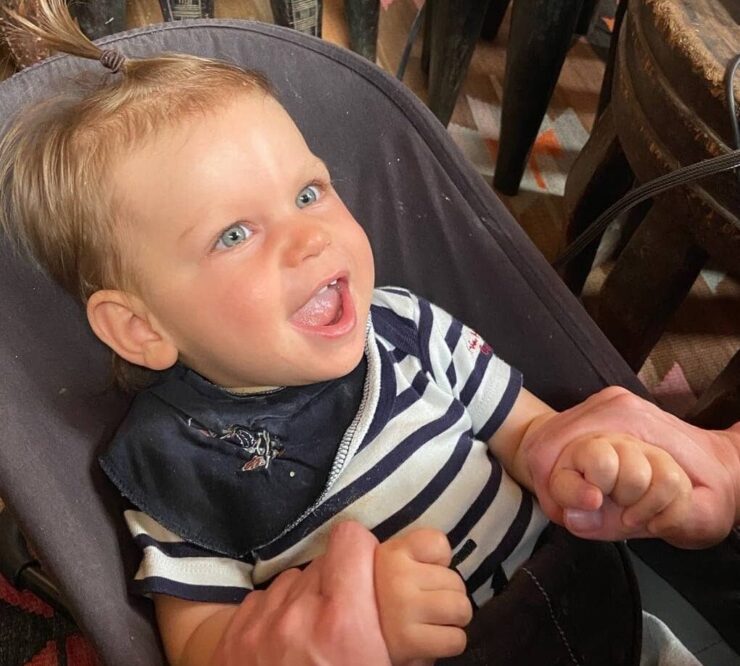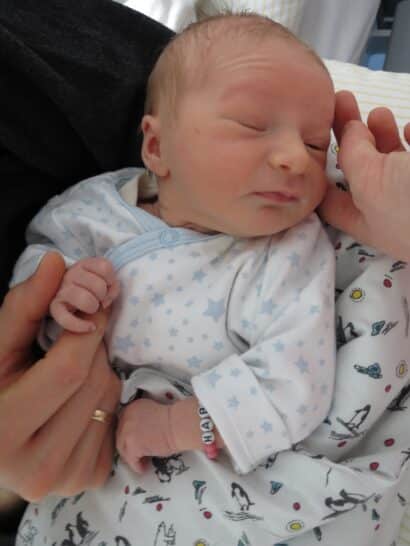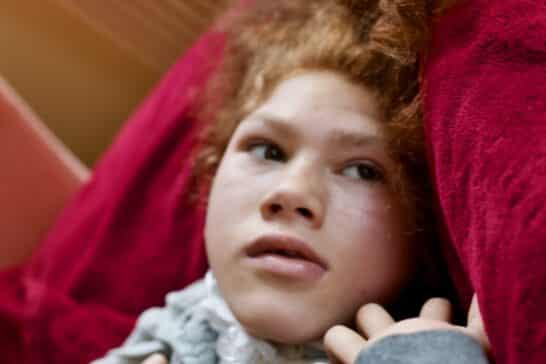Child development is often divided into different areas (gross and fine motor skills, language and cognition, as well as social-emotional development).
Studies have established average ages at which specific developmental milestones will be reached. However, every child develops at their own pace. Slight deviations in one direction or the other are therefore completely normal. During check-ups with the pediatrician, the child’s development is monitored to determine whether it is within the normal range or whether individual areas require special support.
Both motor and cognitive development in children with PCH2 is severely impaired. Certain milestones, such as walking unaided or speaking in complete, grammatically correct sentences, are never achieved by children with PCH2. Nevertheless, children with PCH2 progress through developmental stages, albeit at very different rates from child to child, and the age at which they reach a developmental milestone is usually not comparable to that of healthy children.
Motor Development
Children’s motor development is divided into gross motor skills and fine motor skills. The following table provides an overview of important milestones in motor development in healthy children.
Motor Development Milestones in Healthy Children
| Age | Fine Motor Skills Milestones | Gross Motor Skills Milestones |
| 0 Months | Mmooth pursuit eye movement (SPEM) | |
| 1 Month | Lifts head in prone position | |
| 3 Months | Full head control in prone position; brings hands to mouth; props on forearms in prone position | |
| 5-6 Months | Palmar grasp | Sits with pelvic support; full head control when changing position |
| 9 Months | Inferior pincer grasp | Sits steadily without support |
| 10 Months | Creeps well in prone position; stands with hands held; pulls to stand | |
| 12 Months | Cruises around furniture; stands independently | |
| 14 Months | Superior pincer grasp | |
| 16 Months | Walks well and freely | |
| 2 Years | Walks up and down stairs, holding rail/without holding rail; runs well |
Motor Development in Children With PCH2
Some children with PCH2 achieve the motor development milestones mentioned above (except for running), though usually with significant delays and limitations.
For example, the milestone of head control is achieved by more than half of the children, but not in the same way as in healthy children, where it remains reproducible and constant through changes in position. In many children with PCH2, however, brief periods of intentional head movement in a certain direction are clearly observed.
The milestone of rolling is also achieved by a large number of children with PCH2, and many children also showed attempts to grasp for objects offered to them.
However, more complex skills are only achieved by very few children with PCH2. For example, sitting freely, creeping in prone position or purposeful grasping are only possible for a small number of children with PCH2. For example, purposeful grasping requires considerable effort, is often ataxic, and can only be sustained for a short period of time. Complex motor tasks, such as brushing one’s teeth, are generally not achievable.
Cognitive Development
Cognitive development encompasses the development of language and social behavior. However, skills such as SPEM can also be included in this category.
Cognitive Development Milestones in Healthy Children
| Age | Language | Social Behavior/ Playing |
| 1 Month | Throaty noises | Gazes at and follows objects |
| 3 Months | Spontaneously vocalizes | Social smile |
| 9 Months | Non-reduplicated babbling (different consonants, e.g. “ba-da-ga”) | Inspects objects visually and with hands/mouth |
| 12 Months | Says first deliberate word; imitates language | |
| 18 Months | “Mom” and “dad” or analogous; uses 10-25 words | Hides and searches for toys; places toys in box |
| 2 Years | Two-word sentences (noun + verb) | Imitates adult activities; simple roleplay |
| 3 Years | Four-word sentences; uses pronouns correctly; uses plurals | Engages in roleplay and imaginative play; traces a circle |
| 4 Years | Uses accurate grammar | Can name colors; can draw tadpole persons |
| 5 Years | Accurate pronunciation | Plays games with rules and honors them |
Cognitive Development in Children With PCH2
Similar to motor development, there are also significant differences in children with PCH2 when it comes to cognitive development.
While many PCH2 children respond to caregivers with recognition, show a social smile, fixate on and track high-contrast objects with their eyes, react to sounds, and communicate with vocalizations, only few reach the milestone of uttering specific words.
Developmental Constraints in PCH2 Children
In summary, what applies to the development of PCH2 children is the same as what applies to healthy children: every child is different, and it’s impossible to make an exact prediction.
To use a metaphor: every child has a framework within which they can grow and develop. It may be slightly smaller for children with PCH. However, the extent to which a child with PCH will make use of this framework cannot be accurately predicted in advance.
This depends on many factors: the severity of the symptoms, medication, stimulation and communication, and much more.
Ultimately, however, it depends on that little person who, despite all the adversities that come with their condition, tries to make the best of it by developing, learning, experiencing, understanding, and communicating.
Scientific Background
Data From Literature
- Barth et al. described the severe impairment of motor and cognitive development in children with PCH2 as early as 1995. One of 16 children in his study reached the milestone of sitting freely, while 10 children were able to sit with trunk support. Six children did not reach the milestone of head control.
- Namavar et al. (2011) pointed out the severe impairment of voluntary motor skills in children with PCH2. One of 49 children in this study was able to sit independently, while 18 required support. Twenty-eight children did not achieve head control. Deliberate hand movements were observed in 10 of 55 children.
- In the study conducted by Steinlin et al. (2007), none of the 21 children examined were able to sit independently. One of the 21 children was able to vocalize words, and 8 of 21 children showed at least brief eye fixation and smooth pursuit eye movements.
Natural History Study from 2014
| Skill | Number of Times Achieved | Median Age of Skill Acquisition in Months |
| Gross Motor Skills | ||
| Head control | 23/33 | 12 |
| Creeping in prone position | 3/33 | 24 |
| Rolling over | 18/33 | 12 |
| All-fours position | 2/32 | 78 |
| Sitting | 3/33 | 48 |
| Fine Motor Skills | ||
| Attempted grasping | 25/33 | 12 |
| Purposeful grasping | 8/33 | 42 |
| Language | ||
| Deliberate vocalizations | 19/33 | 24 |
| Uttering specific words | 4/33 | 49,5 |
| Adequate reaction to praise and rebuke | 26/33 | 22 |
| Social smile | 24/33 | 11 |
| Cognition/Communication | ||
| Recognition of caregivers | 32/33 | 8 |
| Reaction to familiar objects | 29/33 | 22 |
| Fixation on objects and SPEM | 26/33 | 14,5 |
| Reaction to sounds | 28/32 | 18 |
Natural History Study from 2023
| Skill | Number of Times Achieved (% and Absolute Amount) | Median Age of Skill Acquisition in Months |
| Gross Motor Skills | ||
| Head control | 65 % (42/65) | 9,5 |
| Creeping in prone position | 14 % (9/65) | 18 |
| Rolling over | 48 % (31/65) | 12 |
| All-fours position | 11 % (7/65) | 19,5 |
| Sitting | 6 % (4/65) | 32 |
| Fine Motor Skills | ||
| Attempted grasping | 69 % (45/65) | 12 |
| Purposeful grasping | 35 % (23/65) | 16,5 |
| Language | ||
| Using specific sounds | 48 % (31/65) | 18 |
| Uttering specific words | 12 % (8/65) | 30 |
| Reaction to praise and rebuke | 69 % (45/65) | 19 |
| Cognition/Communication | ||
| Social smile | 85 % (55/65) | 8 |
| Recognition of caregivers | 94 % (61/65) | 6 |
| Reaction to familiar objects | 88 % (57/65) | 12 |
| Fixating | 86 % (56/65) | 10,5 |
| SPEM | 80 % (52/65) | 12 |
| Reaction to sounds | 77 % (50/65) | 12 |
| Reaction to visual stimuli | 94 % (49/52) | 4,5 |
This entry was written to the best of our knowledge based on the reported experiences of parents of affected children. In addition, currently available data from the 2014 and 2023 Natural History Studies of PCH2 and from general medical literature has been included. It is not a substitute for consulting a medical professional. PCH2cure assumes no liability in this respect.
- Barth, P. G., Blennow, G., Lenard, H. G., Begeer, J. H., Van der Kley, J. M., Hanefeld, F., … & Valk, J. (1995). The syndrome of autosornal recessive pontocerebellar hypoplasia, microcephaly, and extrapyramidal dyskinesia (pontocerebellar hypoplasia type 2) Compiled data from 10 pedigrees. Neurology, 45(2), 311-317.
- Heininger U, Sitzmann F C, Straßburg H-M (2012) Allgemeine und spezielle Prävention. In L. Gortner, S. Meyer & F. C. Sitzmann (Hrsg.) Pädiatrie. Thieme. Stuttgart: 42-61.
- Jenni, O. (2021). Die kindliche Entwicklung verstehen. In :. Springer.
- Largo, R. H., Molinari, L., Pinto, L. C., Weber, M., & Due, G. (1986). Language development of term and preterm children during the first five years of life. Developmental Medicine & Child Neurology, 28(3), 333-350.
- Namavar, Y., Barth, P. G., Kasher, P. R., Van Ruissen, F., Brockmann, K., Bernert, G., … & Poll-The, B. T. (2011). Clinical, neuroradiological and genetic findings in pontocerebellar hypoplasia. Brain, 134(1), 143-156.
- Michaelis, R., Berger, R., Nennstiel-Ratzel, U., & Krägeloh-Mann, I. (2013). Validierte und teilvalidierte Grenzsteine der Entwicklung. Monatsschrift Kinderheilkunde, 161(10).
- Steinlin, M., Klein, A., Haas-Lude, K., Zafeiriou, D., Strozzi, S., Müller, T., … & Boltshauser, E. (2007). Pontocerebellar hypoplasia type 2: variability in clinical and imaging findings. European Journal of Paediatric Neurology, 11(3), 146-152.
- Touwen B C L (1984) Normale neurologische Entwicklung: Die nicht bestehenden inter- und intra-item- Beziehungen. In R. Michaelis, R. Nolte, M. Buchwald-Saal & G. Haas (Hrsg.) Entwicklungsneurologie. Kohlhammer. Stuttgart: 17-24.
- Wehrle, F. M., Caflisch, J., Eichelberger, D. A., Haller, G., Latal, B., Largo, R. H., … & Jenni, O. G. (2021). The importance of childhood for adult health and development—study protocol of the Zurich longitudinal studies. Frontiers in human neuroscience, 14, 612453.
- WHO Multicentre Growth Reference Study Group, & de Onis, M. (2006). WHO Motor Development Study: windows of achievement for six gross motor development milestones. Acta paediatrica, 95, 86-95.
- Natural History Study from 2014: Frölich S. Natürlicher Verlauf der Pontocerebellären Hypoplasie Typ 2 [Inauguraldissertation zur Erlangung des Doktorgrades der Medizin] Tübingen: Eberhard-Karls-Universität; 2014
- Natural History Study von 2023: Kuhn A L. Gastrointestinale Symptome, Ernährung und Gedeihen bei Pontocerebellärer Hypoplasie Typ 2 A [Inauguraldissertation zur Erlangung des Doktorgrades der Medizin] Freiburg im Breisgau: Albert-Ludwigs-Universität; 2023


